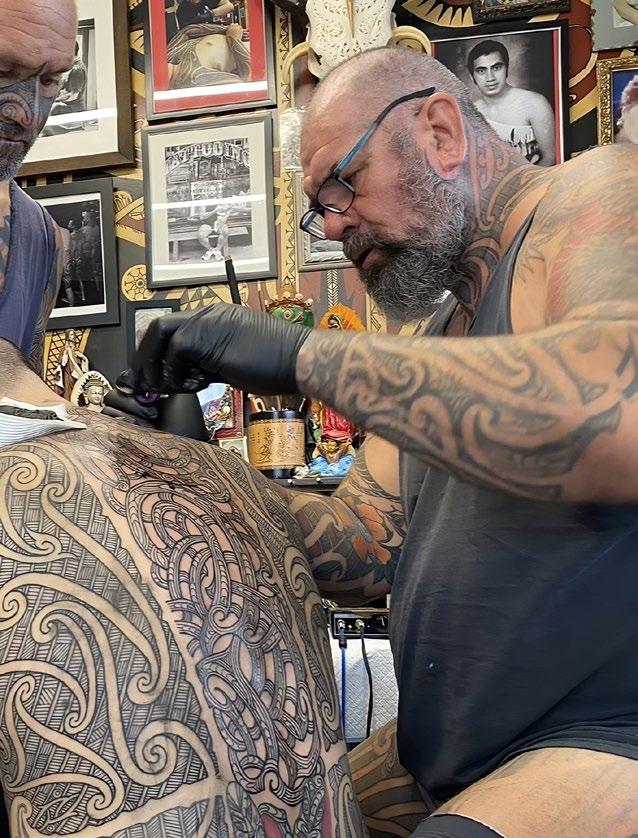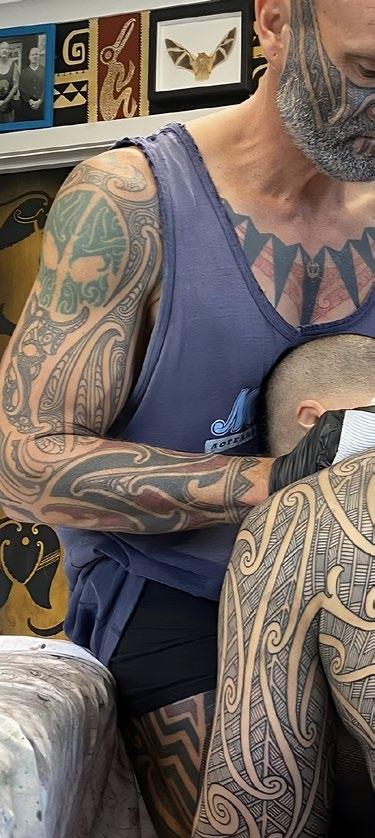
6 minute read
The Man and the Moko
I think we all recognise the stronghold that the generic tattoo has had on global pop culture. Once the hallmark of a sailor, its recent popularity with celebrities and millennials in particular, has seen an exponential increase in skin coverage. Some tattoos are chosen for their deep meaning to the adorned, while others are a design that’s caught the eye. A cultural tattoo is a different art form altogether and for Māori, a moko will never just be a tattoo. It is a transformational process, a statement to the world - I am Māori, and proud to be so.
Words: Britt Coker
Advertisement
Gordon Toi has tattooed moko on thousands of bodies over the last 20 years. He and his whanau live in Māpua where he works with his two apprentices, not just tapping into someone’s skin, but into their DNA. He became a tattooist in the nineties at a time when Māori arts were garnering greater recognition and respect.

“It's been quite phenomenal really, the rebirth of moko. It wasn't always celebrated in the very beginning. Like anything new there was apprehension and lots of questions about who, how and where and all the rest of it, but we pursued it with some vengeance and the result is what it is today, I believe. And I don't think you could sort of point your finger at one person in particular but there was definitely a multi-pronged attempt in terms of revitalising Māori tattooing, especially in the nineties, and most of the guys - there were a couple of ladies - we were all from different tribal areas and most of us worked as carvers initially, before we started doing tattooing. The carvers really had the designs so our people were coming to us and we were designing pieces, and then they would take it to the tattooist in town and he would basically mess it up. So that was the kind of situation that was motivating Māori artists to begin tattooing.”
Gordon acknowledges that every tattooist will have their own process. Although whanau are welcome in the studio, he generally prefers to be with the client without distraction as receiving a moko can be a very intense process. The easier part is usually the consultation; where it is to be placed and what it will look like. And then…
“Once the design is on the body, we then proceed to tattoo it and that’s when traditional karakia is used to clear the way, to give strength, to turn all the switches on. To make sure that the hand is steady, the mind is clear, the person is clear about their intentions of why they want it. To pay tribute to our ancestors that paved the way to allow us to have the opportunity to do the type of work that we do. We pay tribute to our dead, our living. Once the karakia is finished we commence the work, and once it starts, it must continue until it’s finished.”
A puhoro, full body tattoo, will take Gordon five days to complete with his two apprentices stretching the skin as he works. Stretching is a technique that has been used by Samoans for thousands of years so, as a cultural tattooist, Gordon trusted their skills and knowledge. The word tattoo comes from tatau, a Polynesian word meaning ‘to strike’, originating from the tapping sounds the tool makes. Gordon believes incorporating stretching into his practice has allowed him to excel in the artform and to streamline the experience for his clients. But stretching or not, the process is still intense and requires everyone to remain calm and relaxed.
“From the beginning you are metaphorically ripping them apart in a very uncomfortable space, and you’re allowing all sorts of things to be released like historical information, knowledge, trauma, love, hate. All those emotions are caught up in it and you're allowing that to enter or exit the body and then they actually start to rebuild themselves and their transformation literally happens before your very eyes and it's quite inspiring. You think at the end of the day that we would be very, very tired through the work, but in actual fact we're all on a little bit of a high.” Gordon’s work is irreversibly changing how they look at themselves. Not just on the outside, but the inside too.
“Every person that we’ve done, just the transformation of their lives externally, through work, their relationships, everything. When you go down that deep, there are so many lessons to learn from that, that you can utilise outside the environment of our moko studio and this is part of the process of teaching somebody to be a better person, a stronger person, a warrior... It’s a spiritual journey, a physical journey, a mental journey, and if it all goes accordingly to the way that we expect, it is an amazing, amazing journey that unfortunately can only be witnessed by those who are there. I just love hearing how the boys have gone on to better their relationships with their partners, their children, their grandchildren and their work. Everything. It's really a celebration of spirit and of culture.”
Once complete, Gordon will record a short video for them - oral history of the 21st century - providing an explanation of the moko for the client to keep as an educational resource for their whanau, and reference for their adult children should they ever wish to have their own moko.

When it comes to tattooing the moko on non-Māori, traditional tattooists are divided. Gordon sees it as a cultural and societal win. Consequently, he has tattooed many clients around the world including ‘half of Holland’, which sounds a lot, but considering he’s made regular trips to the Netherlands over a twentyyear timespan, that number might not be too far off. Many non-Māori might think of a moko as being a face tattoo, but the name is used more broadly than that. But during the first half of the 20th century, a moko on the face was typically all that could be seen, so the connection may have been established by nonMāori then.

“The whole body itself has certain specific names and each tribe has a name for specific parts of the body … It's like anything, you have to work your way up there and kind of prove your worth, not for anybody else but for yourself. And I think when you [the client] finally make that decision to moko your face, it’s a celebration of your tenacity to identify as

Māori these days. Also, to connect your genealogy, recognise your achievements of yourself in terms of your contribution to your people, to your whanau, to your iwi, to Māoridom.”
Although most of his clients are men, Gordon believes it was wahine toa that kept moko alive during the decades when tattoos were not widely acceptable.

“It was our women that continued to carry the chin moko (moko kauae) through the period of time where the early colonisers and things like religion really had a major impact on our abilities to express ourselves as Māori, including the language. But our women continued to carry that responsibility of moko. Equally so, the carvers of the day were transferring moko design back into the carvings so we are very, very fortunate that our ancestors left those signposts for us to follow, which allows us to enrich that artistic expression as modern day artists.”
Moko served many guises. It could represent your job, your status, and equality (“It made us all the same so there wasn't anyone better than anyone else”). As a disguise too, where a chief working in the gardens may not be so easily identified by visiting iwi until they were close enough to be determined friend or foe. These reasons have naturally morphed with time, but as a nonverbal form of expression, the moko still has plenty to say.
As part of the jolt of colonisation, the initial instinct for early settlers would have been to remain culturally separate and safe; more secure identifying with what was known, than what could be. But we are all more comfortable in our nation’s skin now. Slowly shedding one for another, we are beginning to recognise more clearly our strength in unity, and our uniqueness from the rest of the world.
“Back in the 80s, if you generally saw somebody with a moko on their face there is a good chance they were gang-affiliated, but it's not like that anymore and it will not be like that forever more. Moko is definitely a celebration of Māori recognising their tino rangatiratanga, their status as indigenous Māori and I think that is significant for New Zealanders everywhere. We had this particular type of culture that is not in a museum. It’s living with us side by side, we see it every day now, it's generalised through our sports players, our movies, political parties, it’s everywhere now and I think New Zealand should really celebrate the fact that it's a part of all of us. It is not a Māori thing, it's a New Zealand thing, it’s an Aotearoa thing and that’s something to really celebrate.”










